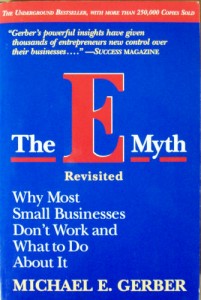This book is all about small business. People go into small business for the wrong reasons and ended up working themselves to exhaustion and quit. The author clearly categorize the three roles of a small business: Technician, Entrepreneur and Manager.
Most people tend to go into business because they’re the best technicians, which are not sufficient to sustain a business. The other two roles are just important to ensure success. The author used the story of Sarah in her “All about pie” store to get his points through – very effective.
In order to be successful, the business owner must turning something repeatable into an operation manual can be duplicated. If it’s not duplicatible, it can not be franchised.
Gerber coined the phrase “The Turn-key revolution”: the business format franchise. “The true product of a business is the business itself.” Ray Kroc’s treated McDonald, the business, as a product in itself.
The Franchise Prototype: Every possible detail of McDonald’s business system was first tested in the Prototype and then controlled to a degree never before possible in a people-intensive business. Once the franchisee learns the system, he is given the key to his own business, thus the name: Turn-Key Operation. The franchisee is licensed the right to use the system, learns how to run it, and then “turns the key.”
“To the Entrepreneur, the Franchise Prototype is the medium through which his vision takes form in the real world. To the Manager, the Franchise Prototype provides the order, the predictability, the system so important to his life. To the Technician, the Prototype is a place in which he is free to do the things he loves to do – technical work.” “It is a proprietary way of doing business that successfully and preferentially differentiate every extraordinary business from every one of its competitors. In this light, every great business in the world is franchise.”
Go to work on your business rather than in it, and ask yourself the following questions:
1. How can I get my business to work, but without me?
2. How can I get my people to work, but without my constant interference?
3. How can I systematize my business in such a way that it could be duplicated 5,000 times, so the 5,000th unit would run as smoothly as the first?
4. How can I own my business, and still be free of it?
5. How can I spend my time doing the work I love to do rather than the work I have to do?
To win the Franchise Prototype game, the following rules are to be followed:
1. The model will provide consistent value to your customers, employees, suppliers, and lenders,
2. Will be operated by people with the lowest possible level of skill. Creating business results that are systems-dependent rather than people-dependent.
3. Will stand out as a place of impeccable order.
4. All work will be documented in Operations Manuals.
5. Will provide a uniformly predictable service to the customers.
6. Will utilize a uniform color, dress and facilities code.
The business development process:
1. Innovation: Ask continuously, “What is standing in the way of my customer getting what he wants form my business?” or “what’s the best way of doing this?” Innovation is the signature of a bold, imaginative hand.
2. Quantification: Take data points – use the management information system.
3. Orchestration: Eliminating descretion, or choice, at the operating level of your business. “If you haven’t orchestrated it, you don’t own it!” It’s the glue that holds you fast to your customers’ perceptions, the certainty that is absent from every other human experience, the order and the logic behind the human craving for reason.
The business development program must consist of the following seven distinct steps:
1. Your primary aim – the vision to bring your business to life, provides you with a purpose, energy, the grist for our day-to-day mill.
2. Your Strategic Objective: a clear statement of what your business has to do ultimately do for you to achieve your Primary Aim.
3. Your Organizational Strategy
4. Your Management Strategy
5. Your People Strategy
6. Your Marketing Strategy
7. Your Systems Strategy
From #5~7, the contents read like a mini MBA program.
The story in the book is a bit corny but effective in getting people to understand. I consider this book a must read for someone who wants to go into business himself/herself.

